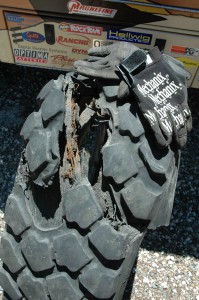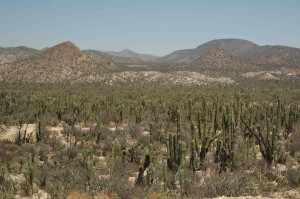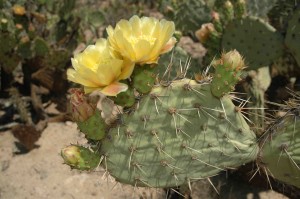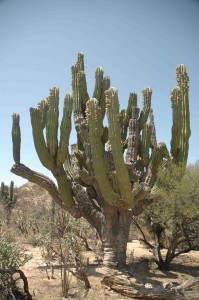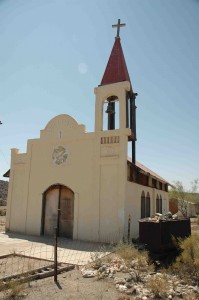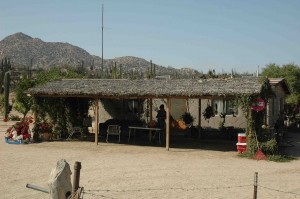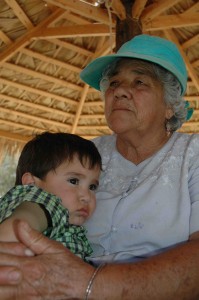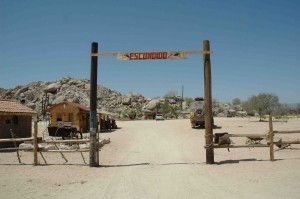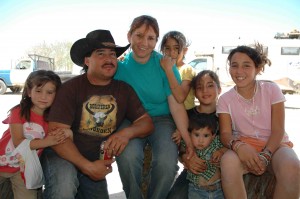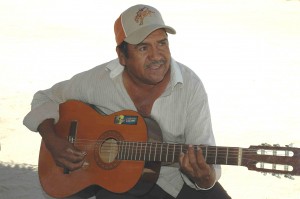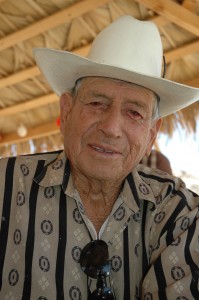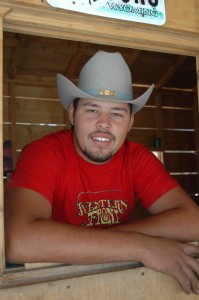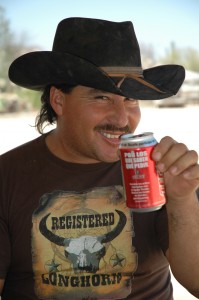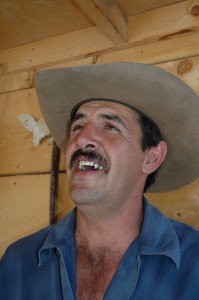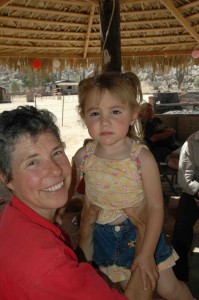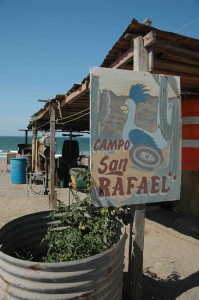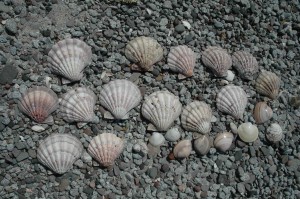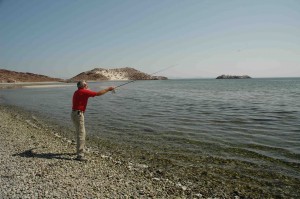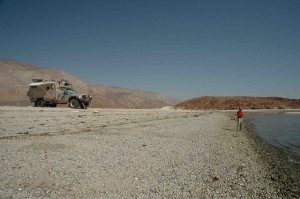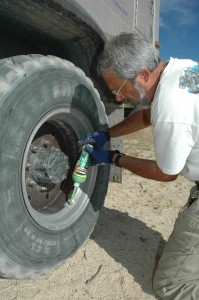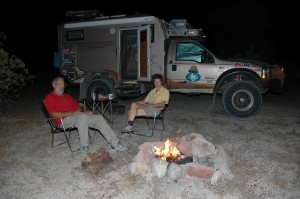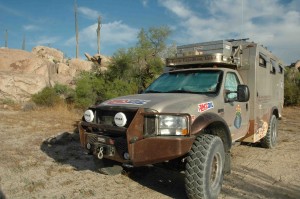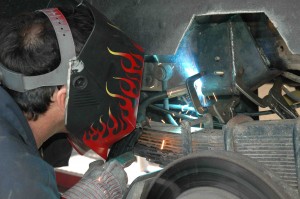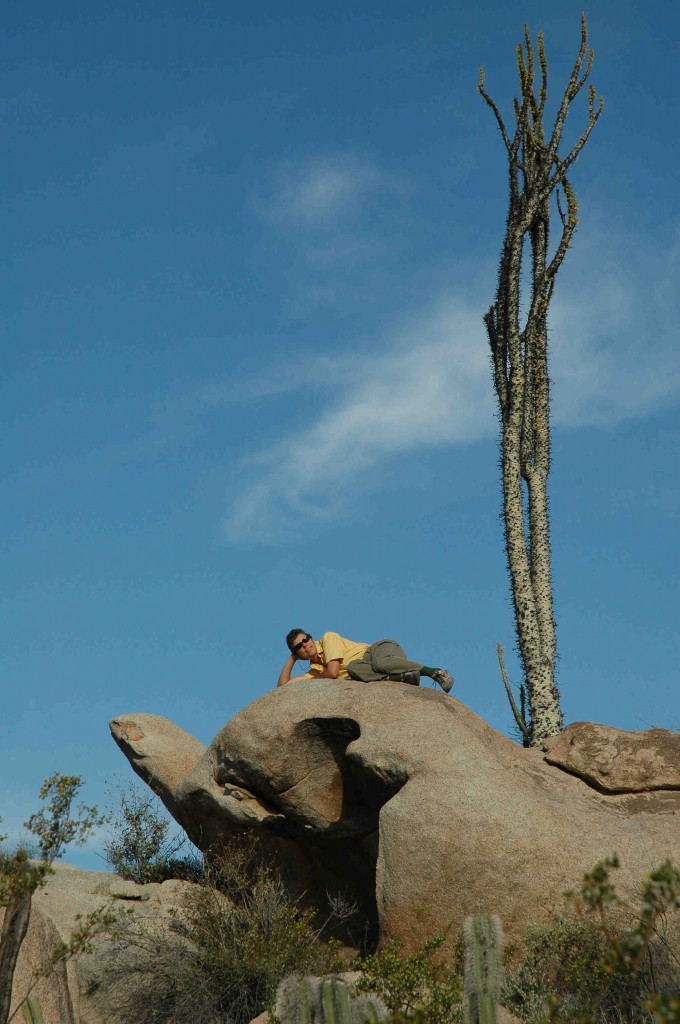Bahía de los Angeles the Hard Way
BAHÍA DE LOS ANGELES – THE HARD WAY
In Search of Baja Bandits!!!
Author: Gary Wescott / Photos by Gary & Monika Wescott
It was afternoon when we aired our tires down, zeroed the GPS, and turned off the pavement of Mex. Hwy 1 west of Vizcaíno. We had followed this route thirteen years ago, and we wondered if folks we had met then at isolated cattle ranches and lonely fish camps were still around.
It was no doubt foolish to explore these backroads alone, with no spare tire and a serious crack in the truck’s frame, but we tend to be overconfident sometimes. It was only 160 miles to Bahía de los Angeles through a waterless desert.
The two-track looked familiar as it snaked off through a garden of cholla, ocotillo, and forests of Giant Cardón cacti. The Cardón is the world’s largest cactus. Nearly endemic to the deserts of the Baja California peninsula, they can reach a height of 70 feet and live over 300 years. We recalled there were some beautiful examples along this route.
Passing through the mostly abandoned farming community of Angel Cesar, the soft sand gave the Power Stroke a lower pitch, asking for 4X4. There were unmarked forks where we could only guess which way to go. Topping a low ridge, we could see the trail in the distance as it wandered east toward the reddish brown mountains and the Sea of Cortez. Not wanting to drive in the dark we camped for the night. A few coyotes were our only company.
As we sat watching the last glow of a tangerine sunset, we laughed about the fear many people have of bandits in Baja. Following last year’s Baja 1000 race, there had been a couple of robberies on the highway between Tijuana and Ensenada. It was front-page news. Now the whole Baja peninsula was a terror zone. Tours and vacations were canceled, and paranoia lurked around every curve in the road. Meanwhile, there were two stabbings in broad daylight in San Diego that never even made the third page. Humm. We’ve always felt that if we could make it through the Los Angeles freeways without getting run over or shot, we were home free!
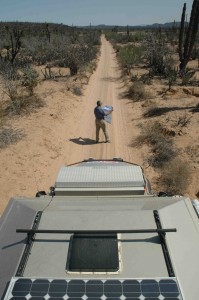
We cross-referenced our map to the GPS to make sure we were where we thought we were, and going in the right direction.
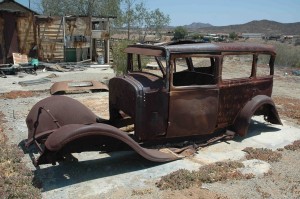
This 1930 Ford seemed to be missing a few parts, but its heritage could be traced to our own Super Duty.
Our first stop in the morning was El Arco. Once an active mining town, it is now nearly deserted except for a military camp and a few families. The huge machinery used for extracting gold sits rusting on the hillside. The shell of a 1930 Ford is symbolically parked outside a crumbling adobe home. The new Mex. Hwy 18 comes in from the west, and there is a side road that goes out to the historic Mission Santa Gertrudis, founded by the Jesuit missionary Jorge Retz in 1751 among the Cochimí Indians of Baja.
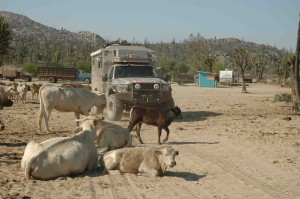
There are few fences in the Baja backcountry. Range cattle need thousands of acres to find enough to eat.
East of El Arco there were a couple of new homesteads since our last visit. We stopped at Rancho Piedra Blanca. The young couple, Alberto and Lupita, and their 3-year old daughter, Darina, were relaxing in the shade of the typical Baja ranch veranda. Over fresh coffee, they proudly told us their plans for an “Eco Camp” they were in the process of building. Sort of a “dude” ranch for individuals or small groups, all part of a government program to bring more tourism into Central Baja.
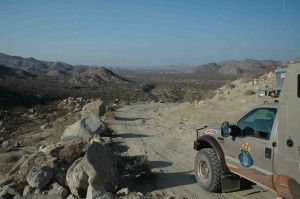
Topping a low ridge, we could see the trail in the distance as it wandered east toward the reddish brown mountains and the Sea of Cortez.
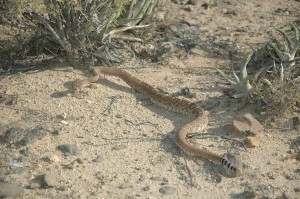
Rattlers like this big guy are not common, but one must use caution in the desert, when medical attention is many hours away.
La Cuesta de La Ley had been one of the most difficult passes to get over for years, requiring 4X4 and some careful driving, but like many Baja challenges, road crews and bulldozers have chiseled away at the boulders and rocks to tame this once intimidating climb. High clearance is still advisable. Making our way down to the fertile plain on the east side of La Cuesta de La Ley, the forest of Giant Cardón was impressive, but the spiny vegetation was so thick, we could not even find an opening to get off the track. An abandoned military outpost offered a perfect place to camp. A new graded road not even on our current maps came in from Guerrero Negro.
Backtracking a little, we came to Rancho Progreso where we had visited years before. The old couple, Lorenzo and his wife, Refugio, greeted us like we had been there yesterday. They were retired now, but their son, Oscar, had married and started his own spread, Rancho Escondido, just up the road. As luck would have it, there was a birthday celebration going on, and of course we were invited.
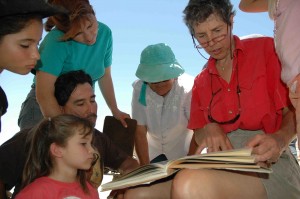
Everyone is fascinated with the Last of Los Californios book as many recognize cousins from their extensive families.
Monika brought out our dog-eared copy of Last of the Californios by Harry W. Crosby, published in 1981. Locals gathered around to learn interesting bits of history they were unaware of. Families of these ranches are so interrelated, many of the persons appearing in photographs in the book were recognized as first, second or third cousins. There is also a fascinating DVD documentary just released that was partially filmed at Rancho Progreso; Corazon Vaquero, (www.corazonvaquero.com)
After our fill of cold Tecates and barbequed chicken, we said goodbye, promising to return sooner than thirteen years!
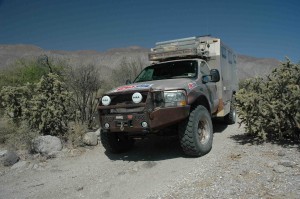 From Rancho Escondido, the road went from bad to worse. We took it easy, not wanting to aggravate the crack in the frame, and without a spare, we knew very well that the nearest Michelin 335/80R 20 XZL tire was sitting in a rack 1,000 miles away in our backyard. Normally, if we had a flat, we would just break it down in camp and fix it. As you can see from the photos, our spare was way beyond any repair. If we had another such failure, or if the frame crack worsened, plan “B” was to have Monika stay with the truck while I hitched a ride to Bay of LA or back to one of the ranches for help. She had enough food and water for a couple of weeks. No problem.
From Rancho Escondido, the road went from bad to worse. We took it easy, not wanting to aggravate the crack in the frame, and without a spare, we knew very well that the nearest Michelin 335/80R 20 XZL tire was sitting in a rack 1,000 miles away in our backyard. Normally, if we had a flat, we would just break it down in camp and fix it. As you can see from the photos, our spare was way beyond any repair. If we had another such failure, or if the frame crack worsened, plan “B” was to have Monika stay with the truck while I hitched a ride to Bay of LA or back to one of the ranches for help. She had enough food and water for a couple of weeks. No problem.
Smooth sand turned to dusty washboard where the old road crossed the “new” and “improved” road. Culverts were washed away; never designed for the savage flooding these arroyos see. We topped two high ridges and snaked down the final grade to Playa San Rafael on the northern end of the bay sharing the name.
Francisco, the resident fisherman, remembered our last visit. He had taken us out to hook a few bass back then, but today, a strong Santa Ana wind was whipping whitecaps off the bay. We kept moving. The road turned inland now, to circumvent the Pico Alberto headlands. We had all but given up our search for another perfect camp when we remembered a small bay reached by an unmarked trail down an arroyo.
The coast was several miles away, but we took a chance. The trail wandered in and out of the arroyo. Soft sand made four-wheel drive a good idea. Mesquite trees raked the sides of the truck, telling us that every time this arroyo flooded, the road changed. In fact, often we could have made our own path had we chosen to.
Just when we were doubting the outcome of this side trip, a long arching white beach came into view, and then a second even more pristine. Small islands dotted a cobalt bay. Clean gravel reached gently under turquoise shallows. A crushed shell track leading to the point stopped abruptly at a four-foot deep tidal channel twenty yards across. Being experienced four-wheelers, we immediately identified this as a stupid idea and a low tide route.
We turned right and pulled up to the crest of sand in the middle of the bay. There was still time to unpack our 7-foot Shimano graphite poles and reel in a couple fish for dinner.
We are hesitant to divulge the exact location of this little treasure. Real Baja aficionados may certainly have extrapolated its name. For the others, we offer this riddle:
Guarded by angles,
Often visited by whales
Who would dare defy the Gods?
A sleeping Indian and his bride
Turned to stone above this soulful bay
A Baja sunrise the color of pigeon blood flowed across the desert like an old sherry. As we wound our way back to the main road, the brilliant flowers of the ocotillo had set the olive gray landscape on fire. Back on the washboard, we unlocked the hubs and rattled north.
Not five miles had passed when the SmarTire monitor on the dash frantically beeped an alarm. A quick glance showed
that the left rear was down to 22 psi and dropping. The SmarTire system has wireless sensors in each tire that transmit the pressure and temperature to a small screen as you drive, warning you if a preset limit is reached. In this case, my limit was set at 25 psi.
I immediately stopped. Sure enough, we could hear the air hissing ominously out of the tread. The SmarTire system had undoubtedly saved the tire, but without a spare, we had to make a temporary repair. It took three Safety Seal plugs to fill the ¾” cut. Would the fix hold?
We blitzed Bahía de Los Angeles, topped up our diesel, and aired up the tires. Our Oasis compressor was surely getting a workout on this trip. The blacktop felt good for a change. It was 41 miles to Mex 1, and then another 64 miles to Cataviña. Turtle Camp waited for us.
A few miles north of Santa Ines, we took an unmarked turn into the huge piles of boulders often called the “Rock Garden”. Pulling into what seemed like a “reserved”spot next to a mesquite tree, we set up the chairs and table, threw a pile of firewood off the roof rack, and poured a glass of wine. We were home. We had named this special spot “Turtle Camp”, because amongst the house-size granite boulders piled everywhere, there is one that distinctly resembles a turtle.
We would be on pavement the rest of the way back to the border. The three Safety Seal plugs were holding, but soapy water showed a small leak. Not daring to add a fourth plug, and not wanting to break the tire down for an inside repair, I pulled out our last resort. Putting a jack under the axle to keep the tire from collapsing, I pumped in a quart of Slime tire sealant. That did the trick. No more bubbles!!
Crossing the border, we headed straight for the TCI Michelin Tire Center in El Cajon where a #5 patch made a permanent repair. Three days later, the engineers at Hellwig designed a pair of thick two-part reinforcement plates, which were welded to the frame on both sides to prevent any future problems.
Baja had been fun, but it had also taken its toll on The Turtle V. That’s part of the price we pay for the privilege of experiencing the desert’s tranquility, for the abundance of seafood, and for the opportunity to meet the friendly people who work and live in this harsh land. We would be back. Bandits? We don’t think so.








